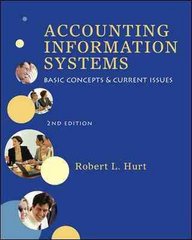Question
Accounts Payable Subsidiary Ledger A financial record of an individualACCOUNT PAYABLEin which entries can be made daily. Accounts Receivable Turnover Used to measure a company's
Accounts Payable Subsidiary Ledger
A financial record of an individualACCOUNT PAYABLEin which entries can be made daily.
Accounts Receivable Turnover
Used to measure a company's ability to collectcashfromcreditcustomers. Found by dividingnet salesby averagenetACCOUNT RECEIVABLE.
Accrual
The recognition of anexpenseor revenue that has occurred but has not yet been recorded.
Accrual Accounting
The attempt to record the financial effects of transactions and other events in the periods in which those transactions or events occur rather than only in the periods in whichcashis received or paid by the business, using all the techniques developed by accountants to apply theMATCHING PRINCIPLE.
Accrual Basis
Method ofACCOUNTINGthat recognizes REVENUE when earned, rather than when collected. Expenses are recognized when incurred rather than when paid.
Accrued Expense
Anexpensethat has occurred but is not recognized in the accounts.
Accrued Interest
INTERESTthat has accumulated between the most recent payment and thesaleof aBONDor other fixed-incomesecurity.
Accumulated Depreciation
TotalDEPRECIATIONpertaining to anASSETor group of assets from the time the assets were placed in services until the date of the FINANCIALSTATEMENTortaxreturn. This total is theCONTRA ACCOUNTto the related asset account.
Accumulation
Profits that are not paid out asDIVIDENDSbut are instead added to the company's capital base.
Acid-Test Ratio
The relationship of a company's current assets that can be converted intocashto its current liabilities. It is determined by dividingQUICK ASSETSby current liabilities.
Acquisition
Onecompanytaking over controlling interest in another company.
Actuary
Mathematician employed by aninsurancecompanyto calculate PREMIUMS, RESERVES,DIVIDENDS, and insurance,PENSION, andANNUITYrates, usingriskfactors obtained from experience tables.
Additional Paid in Capital
Amounts paid for stock in excess of itsPAR VALUEorSTATED VALUE. Also, other amounts paid by stockholders and charged to EQUITY ACCOUNTS other thanCAPITAL STOCK.
Adjusted Basis
After a taxpayer's basis in property is determined, it must be adjusted upward to include any additions of capital to the property and reduced by any returns of capital to the taxpayer. Additions might include improvements to the property and subtractions may includedepreciationordepletion. A taxpayer'sadjusted basisin property is deducted from the amount realized to find thegainorlossonsaleor disposition.
Adjusted Gross Income
Gross incomereduced by business and other specified expenses of individual taxpayers. The amount ofadjusted gross incomeaffects the extent to which medical expenses, non business casualty and theft losses and charitable contributions may be deductible. It is also an important figure in the basis of many other individual planning issues as well as a key line item on theIRSform 1040 and required state forms.Accounts Payable Subsidiary Ledger
A financial record of an individualACCOUNT PAYABLEin which entries can be made daily.
Accounts Receivable Turnover
Used to measure a company's ability to collectcashfromcreditcustomers. Found by dividingnet salesby averagenetACCOUNT RECEIVABLE.
Accrual
The recognition of anexpenseor revenue that has occurred but has not yet been recorded.
Accrual Accounting
The attempt to record the financial effects of transactions and other events in the periods in which those transactions or events occur rather than only in the periods in whichcashis received or paid by the business, using all the techniques developed by accountants to apply theMATCHING PRINCIPLE.
Accrual Basis
Method ofACCOUNTINGthat recognizes REVENUE when earned, rather than when collected. Expenses are recognized when incurred rather than when paid.
Accrued Expense
Anexpensethat has occurred but is not recognized in the accounts.
Accrued Interest
INTERESTthat has accumulated between the most recent payment and thesaleof aBONDor other fixed-incomesecurity.
Accumulated Depreciation
TotalDEPRECIATIONpertaining to anASSETor group of assets from the time the assets were placed in services until the date of the FINANCIALSTATEMENTortaxreturn. This total is theCONTRA ACCOUNTto the related asset account.
Accumulation
Profits that are not paid out asDIVIDENDSbut are instead added to the company's capital base.
Acid-Test Ratio
The relationship of a company's current assets that can be converted intocashto its current liabilities. It is determined by dividingQUICK ASSETSby current liabilities.
Acquisition
Onecompanytaking over controlling interest in another company.
Actuary
Mathematician employed by aninsurancecompanyto calculate PREMIUMS, RESERVES,DIVIDENDS, and insurance,PENSION, andANNUITYrates, usingriskfactors obtained from experience tables.
Additional Paid in Capital
Amounts paid for stock in excess of itsPAR VALUEorSTATED VALUE. Also, other amounts paid by stockholders and charged to EQUITY ACCOUNTS other thanCAPITAL STOCK.
Adjusted Basis
After a taxpayer's basis in property is determined, it must be adjusted upward to include any additions of capital to the property and reduced by any returns of capital to the taxpayer. Additions might include improvements to the property and subtractions may includedepreciationordepletion. A taxpayer'sadjusted basisin property is deducted from the amount realized to find thegainorlossonsaleor disposition.
Adjusted Gross Income
Gross incomereduced by business and other specified expenses of individual taxpayers. The amount ofadjusted gross incomeaffects the extent to which medical expenses, non business casualty and theft losses and charitable contributions may be deductible. It is also an important figure in the basis of many other individual planning issues as well as a key line item on theIRSform 1040 and required state forms.
Question 8
1. Pardon is counterweight accounting______?
2. Could you repeat that are the craft bills____?
3. What did you say is____impartial value accounting_____?
4. I'm sorry transpires to _____the cash, which is collected from the clients but not verified as revenue_____?
5. How chief is ____citations when it comes to accounting_____?
6. Come again is an MIS_____ tale, have you equipped any_______?
7. Could you repeat___ that do you mean by the firm's due cycle______?
8. I'm sorry is Scrap Value in book-keeping______?
9. Which account is answerable for interest billed______?
1o. Pardon is the_____ departmental secretarial system_____?
Step by Step Solution
There are 3 Steps involved in it
Step: 1

Get Instant Access to Expert-Tailored Solutions
See step-by-step solutions with expert insights and AI powered tools for academic success
Step: 2

Step: 3

Ace Your Homework with AI
Get the answers you need in no time with our AI-driven, step-by-step assistance
Get Started


